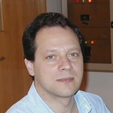Structural Biology Laboratory
 Structural Biology Laboratory
Structural Biology Laboratory

Investigador Principal
Phone (+351) 214469666/156
e-mail frazao@itqb.unl.pt
Areas of research: I have been working on crystallographic studies of macromolecular biomolecules involved in:
1- protease activity
1.1.- aspartic proteases involved in blood pressure control, or in plant development and used in artesanal cheese manufacture
1.2. - cystein proteases
2 - bone formation/control (osteocalcins)
3 - electron transfer processes
3.1. - mono- and multi-heme cytochromes
3.2. - di-iron oxygen or nitric oxide oxido-reductases
3.3. - non-heme mono-iron sulfur oxidase reductases
3.4. - ferredoxins
3.4.1. - high potential iron proteins
3.4.2. - [3Fe-4S]1+/0 [4Fe-4S]2+/1+ Zn2+ ferredoxin
3.5. - hybrid cluster iron-sulfur protein
3.7. - Rieske protein
4. - ribonuclease II
5. - poly-saccharide synthesys
5.1. - UDP-glucose dehydrogenases
5.2. - glucose-1-phosphate uridylyltransferase
6. - amidase
7. - nitroreductase
Hints on ongoing research projects on BceC, amidase or SOR are given at pages indicated above (top left).
At the moment I m also working with projects involving a new Rieske protein, a Yeast transcription factor, two beta-myrcene catabolic enzymes and a phosphomannose isomerase.



